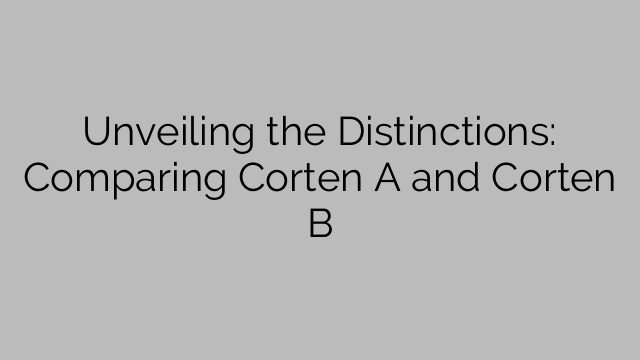Corten A and Corten B are two popular variations of weathering steel, also known as Cor-Ten steel. These materials are highly sought after due to their unique properties, which make them ideal for various construction and architectural applications. Although they share similarities, there are distinct differences between the two that set them apart in terms of composition, usage, and performance.
構成:
Corten A and Corten B both belong to the family of weathering steel, which is primarily composed of iron, chromium, and copper. The primary difference lies in the percentage and presence of other alloying elements.
Corten A is mainly made up of iron and small amounts of phosphorus, copper, chromium, nickel, and molybdenum. This variation is primarily used for decorative purposes and offers good resistance to atmospheric corrosion.
On the other hand, Corten B contains somewhat higher amounts of phosphorus, copper, chromium, and molybdenum. This composition lends itself to enhanced mechanical properties compared to Corten A, making it suitable for structural applications.
Usage:
While both Corten A and Corten B find applications in construction and architectural projects, their specific uses are determined by their respective mechanical properties.
Corten A is commonly used for cladding, architectural facades, and decorative features due to its aesthetic appeal. Its rusted appearance adds a unique rustic element to buildings, making them stand out. Its corrosion-resistant properties are also well-suited for outdoor sculptures and artworks.
On the other hand, Corten B is preferred in structural applications such as bridges, railway cars, and structural frameworks. Its increased mechanical strength and improved resistance to corrosion make it the ideal choice for components that require high durability and structural integrity.
パフォーマンス:
In terms of performance, both Corten A and Corten B exhibit excellent resistance to atmospheric corrosion. This is due to the formation of a tightly adhered protective layer of rust, which acts as a barrier against further corrosion. This natural oxidation process, known as patina development, not only enhances the weathering steel’s appearance but also ensures its long-term durability.
However, Corten B outperforms Corten A in terms of mechanical properties, making it more suitable for structural applications. The higher alloy content provides improved tensile strength, yield strength, and impact resistance, allowing it to withstand heavy loads and external forces.
結論:
In summary, while Corten A and Corten B are both types of weathering steel that share some common properties, their composition, usage, and performance set them apart. Corten A is well-suited for decorative purposes and provides good resistance to atmospheric corrosion, making it ideal for architectural features. On the other hand, Corten B offers enhanced mechanical properties, making it more suitable for structural applications where strength and durability are key requirements.
When selecting between Corten A and Corten B, it is important to consider the specific application and the desired performance characteristics. Understanding these distinctions will ensure the right choice is made, resulting in a long-lasting and visually appealing finished product.
[ad_2]

